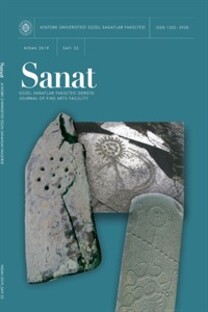SHAKESPEARE’S MASTERY OF PLOT AND COMEDY IN MUCH ADO ABOUT NOTHING
It is a well-known fact that WilliamShakespeare, just like many of hiscontemporaries, was influenced by earlierliterary and non-literary sources while he waswriting his plays. However, Shakespeare didnot remain true to the sources by which hewas inspired neither in terms of content norform. Much Ado About Nothing, which hewrote by making use of the features of NewComedy genre that had emerged in theAncient Greece, is undoubtedly an indicativeof his mastery of plot and comedy. Theplaywright, while utilizing the genre of NewComedy, brought novelties to the playshowing his genius and he knitted, so tospeak, the plot structure in a conscientiousmanner. This study aims to analyse themastery of Shakespeare in creating the plotstructure and comedy, to show the features ofthe New Comedy he made use of and toinvestigate the elements which are purelyShakespearean in Much Ado About Nothing.
SHAKESPEARE’İN OLAY ÖRGÜSÜ VE KOMEDİDEKİ USTALIĞI: YOK YERE YAYGARA
William Shakespeare’in, pek çok çağdaşı gibi, oyunlarını yazarken daha önce yazılmış olan edebi ve edebi olmayan kaynaklardan etkilenmiş olduğu bilinen bir gerçektir. Ne var ki Shakespeare, ilham aldığı kaynaklara ne içerik ne biçem açısından sadık kalmıştır. Antik Yunan’da ortaya çıkmış olan Yeni Komedi türünün özelliklerinden yararlanarak yazdığı Yok Yere Yaygara adlı oyunu, Shakespeare’in hiç şüphesiz olay örgüsü ve komedideki ustalığının bir göstergesidir. Adı geçen oyunda, Yeni Komedi türünden faydalanırken kendi dehasını da ortaya koyarak oyuna yenilikler getiren yazar, olay örgüsünü adeta ilmek ilmek örmüştür. Bu çalışma, Yok Yere Yaygara isimli oyunda Shakespeare’in olay örgüsü ve komedi yaratmadaki ustalığını incelemeyi, oyunu yazarken Yeni Komedi türünün hangi özelliklerinden faydalandığını göstermeyi ve oyunda tamamen Shakespeare’e özgü olan öğeleri araştırmayı hedeflemektedir.
___
- Abrams, M. H. and Harpham G. G. (2009). A Glossary of Literary Terms. Ninth Edition. Boston: Wadsworth Cengage Learning. Bates C. (2004). “Love and courtship”. The Cambridge Companion to Shakespearean Comedy (Edited by Alexander Leggatt). Cambridge: Cambridge University Press. 102-12. Boyce, C. (1996). The Wordsworth Dictionary of Shakespeare. Hertfordshire: Wordsworth Editions Ltd. Brockett O. G. and Hildy F. J. (2014). History of the Theatre. Tenth Edition. Essex: Pearson. Danson, L. (2000). Shakespeare’s Dramatic Genres. New York: Oxford University Press. Garber, M. (2004). Shakespeare After All. New York: Anchor Books. Leggatt, A. (1987). Shakespeare’s Comedy of Love. London and New York: Methuen. McEachern C. (2006). “Introduction”. Much Ado About Nothing. Arden Shakespeare. 22-167. Miola, R. S. (1994). Shakespeare and Classical Comedy. Oxford: Clarendon Press. Riehle, W. (1990). Shakespeare, Plautus and the Humanist Tradition. Cambridge: Brewer. Shakespeare, W. (2006). Much Ado About Nothing. London: Arden Shakespeare. Wells, S. (2017). Shakespeare’s Tragedies: A Very Short Introduction. Oxford: Oxford University Press. Wolfensperger, P. (1994). Shakespeare: Impartial and Partial. Tübingen: Verlag.
- ISSN: 1302-2938
- Yayın Aralığı: 2
- Başlangıç: 1999
- Yayıncı: Cordus
